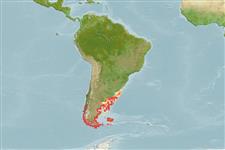Common names from other countries
分類 / Names
共通名の | 類義語 | Catalog of Fishes(部類, 種) | ITIS | CoL | WoRMS | Cloffa
Environment: milieu / climate zone / depth range / distribution range
生態学
海 底生の漂泳性; 深さの範囲 0 - 250 m (Ref. 127764). Temperate; 32°S - 57°S, 76°W - 53°W
Southeast Pacific and Southwest Atlantic: Valparaíso, Chile and Patagonian region of Argentina to Tierra del Fuego.
サイズ / 重さ / 年齢
Maturity: Lm ? range ? - ? cm
Max length : 90.0 cm TL (female); 最大公表体重: 0.00 g
背面の脊椎 (合計) : 7 - 8; 背鰭 (合計) : 23 - 27; 肛門の骨: 0; 臀鰭: 0. Caudal fin emarginate. Body blue brown dorsally and silvery yellow ventrally. First and second dorsal fins grayish, caudal fin brownish, their distal parts yellowish. Anal fin pale brown (Ref. 27363).
Life cycle and mating behavior
Maturities | 繁殖 | Spawnings | Egg(s) | Fecundities | 幼生
Corporacion de Fomento de la Produccion (Chile), 1980. Catálogo de recursos pesqueros Chile. Instituto de Fomento Pesquero, Gerencia de Desarollo, CORFO, Santiago, Chile. (Ref. 5964)
CITES (Ref. 128078)
Not Evaluated
Human uses
水産業: 少数商業の
用具
特記事項
XMLをダウンロードして下さい
インターネットの情報源
Estimates based on models
Preferred temperature (Ref.
115969): 7 - 16.1, mean 10.7 (based on 172 cells).
Phylogenetic diversity index (Ref.
82804): PD
50 = 1.5000 [Uniqueness, from 0.5 = low to 2.0 = high].
Bayesian length-weight: a=0.00977 (0.00428 - 0.02232), b=3.06 (2.85 - 3.27), in cm Total Length, based on LWR estimates for this (Sub)family-body shape (Ref.
93245).
栄養段階 (Ref.
69278): 3.5 ±0.41 se; based on food items.
回復力 (Ref.
120179): 手段, 1.4年~4.4年の倍増期間の最小個体群 (Assuming tm <4).
Fishing Vulnerability (Ref.
59153): High vulnerability (61 of 100).
Climate Vulnerability (Ref.
125649): Very high vulnerability (100 of 100).
